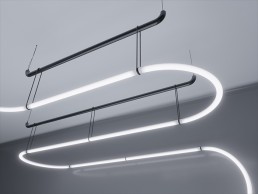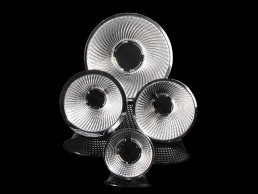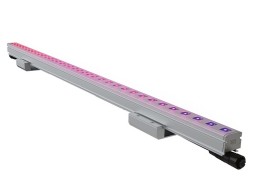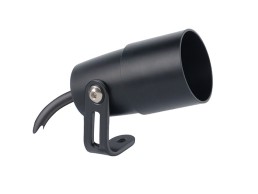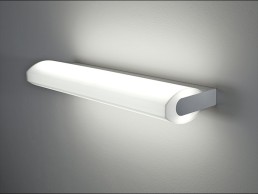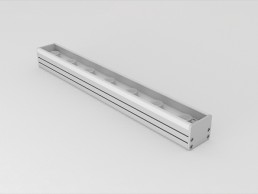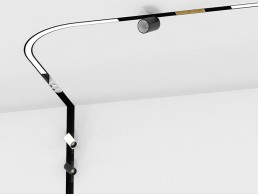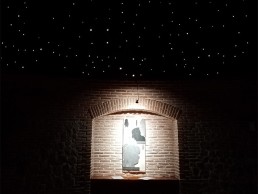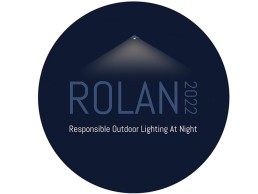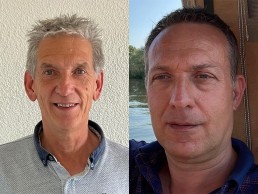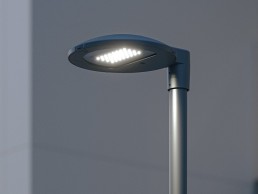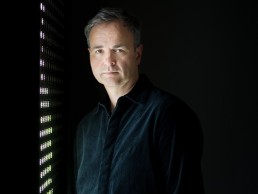Lumolamp Gamma
The Gamma system is an elegant lighting system, specifically designed for public spaces. A combination of luminous tubes connected with precious metal details give the structure a distinctive character. The modularity of the system enables its exact fit into designated spaces. The most characteristic detail of this concept is a metal sling that, highlighted by subtle lighting, creates an evocative atmosphere of the place unattainable by traditional methods of lighting.
LEDiL Adelia
Adelia aluminium reflectors combine stunning high-quality aesthetics with premium light quality. With a beautiful shiny finish, the surface of these innovative reflectors is optimised to show no greyness or haze, ensuring an aesthetically beautiful look. Fitting seamlessly into beautiful lighting designs, Adelia takes track and downlight concepts to new heights. A perfect complement to LEDiL’s assortment of premium retail lenses and reflectors..
OneEightyOne D-Series
OneEightyOne has upgraded the D-Series. The pixel linear is available in RGB, RGBW (3000K or 4000K) and tunable white (2700-5500K). Every single LED is individually controllable. The fixture has a pixel pitch of 25mm. With 60 fps data transfer, super smooth colour changes are assured. Due to 48V input voltage long runs can be achieved. With its durable IP66 rated housing, this product is suitable for every façade lighting project.
LightGraphix LD51
All of LightGraphix’s products are developed with glare control in mind, and the company is constantly evolving the ways in which it can improve this. As well as its existing half cowl, a full anti-glare cowl is now available on its LD51 miniature spotlight, helping to reduce glare from all angles. This cowl can be painted in any of LightGraphix’s standard, or custom RAL wet spray colours.
Hacel Cenaro
A unique and creative wall light, Cenaro is available in a choice of lumen outputs, delivering up to 2970 lumens with efficacies of up to 131lm/W. Cenaro illustrates a seamless combination of curved, softly diffused opal polycarbonate and structured steel, creatively blended to offer a distinctively stylish LED wall light. Presenting a perfect balance of both uplight and downlight, Cenaro is available with the latest wireless lighting controls via an app, enabling users to interact with lighting to suit their individual, group, or special requirements.
LEDFlex Rigid Grazer
Rigid Grazer is the latest addition to LEDFlex’s portfolio of lighting solutions. The non-encapsulated, rigid PCB offers long and seamless runs of fixture, ensuring a flawless grazing finish to any interior. Available in single and dual beam angles of 20°, 30°, 20x45° and 110x70°, Rigid Grazer offers a wider pitch, leading to higher efficiency for long term use, due to a reduction in power consumption. It is also available in a comprehensive range of colour temperatures, spanning 2600-6500K.
Petridis Storm
Available in surface or recessed options, Storm is a 24V DC low voltage aluminium profile for tracking lights with smart magnet technology. It is an ideal solution for small showcases, homes, rest areas, museums, hotels, exhibition halls and generally for many architectural projects.
Designers Mind: Beauty in Design as a Tool for Restoration
Designers Mind contributor Martina Frattura explains her recent research into the quantification of beauty, and how a new aesthetic sensibility could improve our lighting design choices.
“Beauty is the greatest power in this world”. While the writer Anatole France stated this in the 19th century, more than a hundred years later, beauty is still considered a by-product of function, while aesthetics and emotions are mystified and labeled as difficult to study.
The global pandemic led us to experiment with how the environment affects our physiological wellbeing. At the same time, the progress of cognitive neuroscience created an opening for the scientific world to an interdisciplinary approach, called Neuroscience of Architecture, which takes into account the experiential dimension of architecture in aesthetic terms.
So what are the aspects of the architectural experience? Vision, within the sensory segment, dominates the perception of architectural spaces and is responsible for the elaboration of the characteristics of a building in a “bottom-up” fashion. A controlled degree of complexity coupled with the ability to feel comfortable appears to induce positive reactions to our environment. In other words, beauty develops as a state of balance between curiosity and familiarity, and the degree to which these characteristics of the places we inhabit influence how we feel.
The similarities between Beauty and Light
Beauty as a visual necessity, and lighting as a means of vision become systematic factors of a unique relationship: the connection that is created between one’s self and the surrounding world. They both direct attention by creating a hierarchy of reading what we have around us and attributing value to it. Beauty and light are therefore keys to our minds’ permeability: light establishes the way we perceive space, facilitating or altering our understanding of it, while beauty helps us feel involved through the pleasantness of the space.
The degree of affinity that can be established between a person and an external element (Norman, 2005) can be influenced by the ability of lighting to convey this pleasant feeling.
Conscious and unconscious factors, visual and non-visual signals, contribute equally to the experience of emotion, and it follows that integrated design can lead users to experience emotional responses to beautiful objects, including architecture.
Transforming common beauty emblems into design cues
And where do we see beauty? The perception of beauty could be altered by education, cultural upbringing, and personal experience. For this reason, I have investigated 10 different countries, proposing to more than 160 people an empirical study on beauty as a key factor for soft charm in architecture. I chose to work with user-based research to verify the hypothesis that direct attention could be restored in the built environments through interaction with beauty. To do this, the experiment was designed to couple with environmental psychology studies, according to which nature works by lessening cognitive processes and improving the ability to concentrate.
Can we use our perception of beauty to replenish our mental energies? The results of the studies would suggest so.
Two types of data, quantitative and qualitative, were collected. The first dataset, consisting of EEG (Electroencephalogram) and GSR (Galvanic Skin Response) suggested that exposure to beauty may be associated with a decrease in attention fatigue, hence an improvement in direct attention. The second system is created from the answers of each participant to the question: “Where do you see beauty?” and it revealed four macro topics for all the people tested:
Family/partners/pets; objects of affection; landscapes; everything that is “above eye level”.
A thematic approach was chosen to analyse the data with the aim of identifying patterns that suggest the following aesthetic needs of a user in a space: feeling at ease; having an experience that is in tune with previous ones; maintaining prolonged engagement; achieving an immediate positive approach to space.
When translated into design cues, as an attempt to apply empirical aesthetics directly to the neuroscience of architecture, these global themes could help create beauty by addressing key issues such as purpose, context, and process.
Artificial lighting recalling pleasant effects
Can lighting design recall the effects of beauty? Answering this question might improve the applied lighting strategy and therefore the overall sense of wellbeing in a space, which is why I tried to correspond to the aesthetic demands raised by the qualitative research.
“Feeling at ease” - Lighting planning should consider the non-visual effects of light exposure, for example the circadian rhythm. While respecting our changing need for stimulation and relaxation, the choice of the light spectrum and exposure time should be tailored to the type of activity required.
“Previous experiences” - As a cue for positive emotions, lighting should have familiar details, again based on the end use of that space, which could be translated in colour temperatures and direction of light appropriate to the activities. The latter is of great importance, as its influence encompasses both non-visual and visual effects, allowing for a fully pleasant experience of space.
“Being engaged with the space” - The lighting should be designed and organised in such a way as to provide continuous care: the spatial transitions, as well as the dedicated areas, should have a particular light study together with a global one, allowing a reading of the space as a whole.
“Instant positive approach” - The space should be alluring, so that curiosity does its part, adding value with focal glow and play of brilliance effects.
It would therefore seem that the aesthetic value of a space depends on the fusion of various elements in a single positive impression and that the foundation of our search for beauty is based on experimentation both in variety and in coherence.
In other words, the ability to recognise beauty depends on our need to encounter it.
Instinctively and intuitively, we proceed to discover the pleasant aspects in every environment we find ourselves in, constantly restructuring the space and giving it new meanings while approaching special values to something in particular.
The sensory and emotional response patterns may suggest the basis of our experience and despite individual differences, these patterns could help design beauty-informed lighting scenarios. Luckily, beauty and function are not that far apart.
And you, where do you see beauty?
Have you heard about ALAN? Now, there is also ROLAN!
In this article, Dr. Karolina M. Zielinska-Dabkowska examines the new ROLAN movement and points out why this might be the next big thing for lighting professionals.
Artificial light at night (ALAN) is a term that was first used in an article published in Science News by Ben Harder in 2002 [1]. It described the noticeable effects of artificial light at night on ecology, then a few months later, another researcher, Ben Clarke, used this term when investigating outdoor lighting and crime [2]. ALAN was also used in the context of astronomy in 2004, by Kohei Narisada and Duco Schreuder, in their Light Pollution Handbook [3]. As years passed by, numerous researchers began to refer to this term and there is even an ALAN Research Literature Database [4].
However, it took another decade for ALAN to become a larger movement. This began in 2013, when the first ALAN conference took place in Berlin/Germany (arc reported about this event at the time) [5]. Following this, a series of conferences were held in Leicester, UK; Sherbrooke, Canada; Cluj-Napoca, Romania; and Salt Lake City, USA. Then more recently, two conferences were held online, due to the Covid-19 pandemic. The next conference is planned for 2023 in Calgary, Canada.
The ALAN conference series is dedicated to examining all aspects of artificial light at night. The broad scope of the conference includes how light is produced (e.g. technologies, industry, and lighting design), where it is present (e.g. remote sensing); what effects it has on humans and the environment (e.g. ecology); how it is perceived by the public (e.g. perceptions of safety and security), and how the benefits and detriments of lighting may be better balanced, controlled and managed by regulations.
More recently, in the general consciousness, the term ALAN has been connected to the work of the International Dark Sky-Association (IDA), a non-profit organisation, whose mission it is to protect the night from light pollution [6]. The IDA is known for its award-winning International Dark Sky Places (IDSP) programme that encourages communities, parks and protected areas around the world to preserve and protect dark sites through responsible lighting policies and public education, as well as via their Fixture Seal of Approval (FSA) programme, global conference series Under One Sky, and other initiatives.
The term ALAN was also used in 2021, in conjunction with the work of the Artificial Light at Night Working Group, which gathered 20 experts from various fields to participate in the “Dark and Quiet Skies for Science and Society II” conference, which was co-organised by the United Nations Office for Outer Space Affairs (UNOOSA), the International Astronomical Union (UIA) and the Government of Spain. After the event, the main results of the conference were published in the Dark and Quiet Skies II Working Group Reports [7].
Interestingly, the International Commission on Illumination (CIE) [8], which is the international authority devoted to worldwide cooperation and the exchange of information on all matters relating to the science and art of light and lighting, colour and vision, photobiology, and image technology, never recognised and adopted this term in their vocabulary (the terms and definitions contained in the international standard CIE S 017:2020 ILV: International Lighting Vocabulary, 2nd edition) [9].
Considering their role, it’s crucial that the term ALAN is recognised by the CIE and other lighting bodies, and that this occurs in the very near future in order to reduce the light pollution produced by ground-based lighting installations; this is necessary to support night-time professional and amateur astronomical observations, undisturbed human sleep, and the correct functioning of flora and fauna.
Although the ALAN movement and the ideas behind it are very valuable and important, it involves quite an enclosed circle of researchers whose recent findings are often highly scientific, with very little direct applicable knowledge for lighting professionals.
Additionally, the language and physical quantity/measurement units used differ from those that lighting professionals currently apply in their daily practice, which also hinders communication and the application of these new research findings (Table 1).
| Physical Quantity | Lighting Professionals | ALAN Researchers |
| Irradiance, Ee (W/m2) | Rare | common |
| Illuminance, Ev (lx) | common | rare |
| PAR* photon flux density (PPFD) EPAR (µmol photons/m2) | not used | rare |
| Radiance, Le (W/m²·sr) | not used | rare |
| Luminance, Lv (cd/m2) | common | not used |
| Sky radiance (astronomy) Lsky, SQM (mags/arcsec²) | not used | rare |
| Radiant flux, Φe (W) | not used | rare |
| Luminous flux, Φv (lm) | common | rare |
| PAR* photon flux (PPF) ΦPAR (µmol photons/s) | not used | rare |
| Spectral power distribution (SPD; e.g., spectral irradiance in W/m²∙nm) | rare (increasing) | rare (increasing) |
| Correlated color temperature (CCT; K) | common | rare |
| Color rendering index (CRI; Ra) | common | not used |
| Flicker frequency (Hz) | rare (increasing) | not used |
| Flicker % | rare (increasing) | not used |
| (Degree of) Polarisation | not used | just emerging |
Today, there is an awareness of water, air, and soil pollution and the impact that they have on the entire biosphere, including humans, flora, and fauna. However, artificial lighting as a pollutant has been neglected for a long time and only recently has it been considered a potential pollutant.
There’s no denying that lighting professionals need to educate themselves – when they are better educated, the benefits of this extend to everyone, not only human beings but the entire ecosystem.
With the recent climate change emergency and environmental degradation, a different approach to designing outdoor lighting is necessary, instead of relying upon the outdated, traditional, human-centred approach that lighting professionals have used in the past. This involves a new paradigm shift in exterior illumination that provides responsible outdoor light at night in order to protect planet Earth, and to also transform the existing world into a healthier environment. The immense challenge for the implementation of the above goal involves skilful lighting design based on a foundation of solid research, so the negative aspects of outdoor lighting on the environment, public health, wellbeing and life quality are minimised. This inspired me to think about the most effective and practical way to educate lighting professionals. It seemed necessary to have a dialogue with ALAN experts, and to also translate the scientific research and complex knowledge into easy-to-understand information.
Out of this need, the Responsible Outdoor Lighting at Night (ROLAN) movement was established in 2022, with the first conference held online [11]. This two-day event gathered not only well-respected ALAN researchers but also esteemed lighting professionals whose recent work is more environmentally conscious and sensitive to protecting dark skies and the nocturnal landscape.
This platform provided a new form of communication and exchange between these two divergent groups, as well as the possibility of presenting their work and sharing their unique knowledge.
ROLAN 2022 was organised by the ILLUME research group from the Gdansk University of Technology, Poland, [12] and the Society of Light and Lighting (SLL) from the UK [13]. There were also other Founding Partners that were invited to join this movement, including the International Dark‐Sky Association, the International Association of Lighting Designers [14], the Illuminating Engineering Society [15], the Institution of Lighting Professionals [16], and the Lighting Industry Association [17].
ROLAN 2022 Takeaways
ROLAN 2022 was born out of the need to facilitate a much‐needed collaboration, and to offer the support necessary to improve lighting practice, enhance research, and provide networking opportunities between practitioners, researchers and manufacturers. The conference was held over two days between 12-13 May 2022, with stimulating talks and panel discussions that involved 32 speakers from around the world. An interdisciplinary format was used for the event, which allowed for an increased understanding of ROLAN topics [18].
These talks were divided into four dedicated sessions. In session one: Losing our dark nights – the audience heard from astronomers and astrophysicists about the extent and consequences of light pollution from urban environments. In session two: called Best lighting practice(s) to reduce light pollution – experienced lighting professionals used different case studies to explain and demonstrate the various ways in which we can minimise the impact of outdoor illumination, by reducing light pollution. In the third session: Light pollution legal aspects – the participants learned about the legal frameworks and light pollution laws and guidelines that exist in different countries, including Slovenia, Germany, France, Poland, and the UK. In the fourth session: The impact of light exposure at night on the environment and humans – researchers discussed the negative consequences of improperly designed outdoor illumination on nature and all living beings. Each one of the four sessions was summed up with panel discussions to point out the most important findings.
In the afternoon of the last day of the event, representatives of the ROLAN Founding Partners had the opportunity to give their feedback on the event, and to also explain the reason why each organisation decided to support the ROLAN conference and movement.
According to Ruskin Hartley, CEO and Executive Director of the International Dark‐Sky Association (IDA): “It has been absolutely fascinating, almost like a university-depth course. There seems to be a violent agreement in terms of what needs to be done, in terms of high-level principles. We have some wonderful examples of projects from around the world, where in a sense money is no object, so you can bring the right people and the right team together to get this right. There also appears to be an agreement on the real challenges. How do you get this out to scale, how do you take it out beyond the design community, down to the consumer level? How can we take this energy and make it simple and actionable for anyone who wants to be part of the solution? The other key message that came out of the conversations was how do we make this an emotional issue that everyone cares about? For IDA, that is why we have been involved in this. The conference brought the whole world together to talk about this set of issues. How do we take it forward so that the growing number of people around the world, who want to be part of the solution have access to the tools and resources that they need? To talk to their neighbours, to talk to their communities, to talk to officials about the steps they can take. I hope this is just the start of the conversation as we move forward together to put the right tools in place.”
Andrew Bissel, President of the Society of Light and Lighting (SLL) said of the conference: “It was fascinating, there is so much information that has been shared with everyone. From an SLL point of view it is something that has become a topic that we want to take further and explore with our lighting guides. We have LG21 Protecting the night-time environment [19], which is designing for dark skies, but we need to expand on that. We need to start looking at all of our lighting guides, such as the office lighting guide - office lighting its current brightness, when it is left on at 4pm, emits a huge amount of light into the streetscape and into the night sky. We need start putting a Dark Sky section into every lighting guide that we have within the SLL and get people to understand the sheer scale of the impact that every building has. When you add up each building, the school, the hospital, the offices, not just the public realm and roads – we have a huge problem with too much light at night. So, from an SLL point of view, if we provide the right advice and the right education, we will bring about change, so it was absolutely important that we were part of ROLAN.”
Bob Bohannon, Head of Policy & Academy of The Lighting Industry Association (LIA) highlighted the need for this kind of event, saying: “ Part of what we do at the LIA is we teach. We communicate with the Government, with manufacturers and out to local authorities. How do we take these emotional methods and explain what we have to achieve? ROLAN was a great two days of joining up the gaps so we can make this real, street by street, town by town.”
Monica Luz Lobo, President of the IALD, added: “It’s an honour to support this opportunity to give light to this topic with this highly skilled line up of panelists. We are sure the collaboration between research and practice is key to deliver excellence in lighting and to improve human light.”
Susanne Seitinger, President of the IES, considered this event to be a great opportunity: “IES’s mission statement is to improve the lit environment by bringing those together with lighting knowledge, and by translating that knowledge into actions that benefit the public – and I think everyone here has talked about how what we do has a significant impact on urban life, on home life, on health and wellbeing. Emerging from the pandemic, I felt this strong new resurgence and interest in how people structure their environments. We all had to, for better or worse, figure out how to create environments that are healthier, that we can inhabit 24/7 in very different ways – and now thankfully, we are able to re-inhabit the public space too, which is the most important part, because this is where we find connections.”
Lastly, Graham Festenstein, Vice President of the ILP, said: “This has brought together different disciplines and specialisms across lighting and has facilitated great discussions. Collaboration is really important, and hopefully this will kickstart more collaboration between us all. At ILP, our role is furthering best practice in exterior lighting, and the environmental impacts have been important to us for many, many years. As a professional body, from a practical perspective we want to collaborate, we want to be able to work with our research colleagues who can give us the evidence. What we want is evidence-based research, and to incorporate this into best practice, and our application guidances – and with that, hopefully influence standards. And that follows on, in terms of being able to bring the evidence to policy makers, politicians and the public. Lighting strategy is a social and political project and I think that really sums up our view as a professional body – and it’s one of our priorities.”
What next?
At the moment, seven Founding Partners are working on the ROLAN manifesto, and this declaration will be presented to the lighting community in October 2022 during Light + Building in Frankfurt.
The SLL are in the process of making all recordings from the conference available to be purchased on demand, so all this knowledge will soon be available to a wider audience.
There was also a special issue of Light Lines from the SLL on the occasion of the ROLAN 2022 conference, with written contributions from selected participating experts in lighting design, biology, medicine, astronomy, and public engagement [20].
ROLAN was possible with the financial support of four dedicated sponsors. Diamond sponsor: Thorn Lighting from the UK, Gold Sponsor: Filix Lighting from Croatia, and two silver sponsors: GL Optics from Poland, and Selux from Germany.
There are also other lighting manufacturers who are adapting their products based on recent ALAN research in order to provide lower CCT options, along with reduced blue light content, directional, full cut-off and fully shielded luminaires with integrated lighting controls, and this trend continues to grow. It will be interesting to see what the lighting industry is going to present during Light + Building this year, and if spectral power distribution (SPD) and flicker will be considered in the luminaires exhibited at the event.
For more information about ROLAN 2022 event please contact Conference Chair: k.zielinska-dabkowska@pg.edu.pl
References
1. Harder, B. Deprived of darkness: The unnatural ecology of artificial light at night. Science News, 2002, 161, pp. 248-249. Available online: https://www.sciencenews.org/article/deprived-darkness (accessed on 2 August 2022)
2. Clark., B. Outdoor lighting and crime. Part 1: Little or no benefit. Astronomical Society of Victoria, Inc. 2002. Available online: https://bit.ly/3QhJEQY (accessed on 2 August 2022)
3. Narisada, K.; Schreuder, D.A. Light Pollution Handbook. Dordrecht: Springer, 2004
4. ALAN_DB. Available online: http://alandb.darksky.org (accessed on 2 August 2022)
5. Zielinska-Dabkowska K.M., The Value of Less Light. arc 2013, 77, p.150.
6 Who we are. Available online: https://www.darksky.org/about/ (accessed on 2 August 2022)
7. https://noirlab.edu/public/products/techdocs/techdoc051/
8. About the CIE. Available online: https://cie.co.at/about-cie (accessed on 2 August 2022)
9. E-ILV. Available online: https://cie.co.at/e-ilv (accessed on 2 August 2022)
10. Pérez Vega, C.; Zielinska-Dabkowska, K.M.; Schroer, S.; Jechow, A.; Hölker, F. A Systematic Review for Establishing Relevant Environmental Parameters for Urban Lighting: Translating Research into Practice. Sustainability 2022, 14, 1107. https://doi.org/10.3390/su14031107
11. Responsible Outdoor Lighting at Night (ROLAN) 2022. arc 2022, 127, s.118-119. Available online: https://issuu.com/mondiale/docs/arc127/118 (accessed on 2 August 2022)
12. ILLUME. Available online: https://wilis.pg.edu.pl/en/department-geodesy/illume (accessed on 2 August 2022)
13. Society of Light And Lighting (SLL). Available online: https://www.cibse.org/society-of-light-and-lighting (accessed on 2 August 2022)
14. About IALD. Available online: https://www.iald.org/About/About-the-IALD (accessed on 2 August 2022)
15. About the IES. Available online: https://www.ies.org/about/ (accessed on 2 August 2022)
16. About The ILP. Available online: https://theilp.org.uk/about/ (accessed on 2 August 2022)
17. The Lighting Industry Association. Available online: https://www.thelia.org.uk/# (accessed on 2 August 2022)
18. Programme. Available online: https://sforce.co/3Sr8DTU (accessed on 2 August 2022)
19. LG21 Protecting the night-time environment (2021). Available online: https://bit.ly/3OZgvJ4 (accessed on 2 August 2022)
20. SLL Light Lines 2022,15, 3. Available online: https://bit.ly/3P98hhw (accessed on 2 August 2022)
GreenLight Alliance: TM65: a driver manufacturer’s perspective
Rob Bremmert, Quality Engineer and Patrick van der Meulen, Business Development Manager at eldoLED, break down CIBSE’s TM65 initiative, and explain what it means for driver manufacturers.
The global building industry’s response to national net-zero carbon targets will be a big factor in determining whether humanity avoids a catastrophic climate crisis in the coming decades.
Figures for the UK published by the UK Green Building Council (UKGBC) show that the built environment is responsible for more than 25% of total UK greenhouse gas (GHG) emissions. Annual emissions from the building sector have fallen by around 30% since the turn of the century, but this is largely attributable to the growth in renewables, mostly wind and solar, as a proportion of total electricity generation. In other words, it is not the result of any specific initiative for which the building sector can take credit, but is largely the result of government policy for the electricity industry.
Nevertheless, this means that operational emissions – to heat and light buildings and to power appliances – are on a downward trajectory. Harder to reduce are the embodied carbon emissions generated by the production of building materials and appliances, by the construction process itself, and by the disposal and decommissioning of equipment and structures. But without a massive reduction in embodied carbon emissions, the building sector has no chance of reaching net zero.
The first step in reducing the carbon built into new construction projects, refurbished, or re-equipped buildings, is to understand how much embodied GHG, measured in equivalent kilograms of carbon dioxide (kgCO2e), is in the various components of a building project.
This is why the TM65 initiative from CIBSE has attracted the attention of environmentally aware individuals and organisations in the lighting industry, not only in the UK, but around the world: for the first time it gives lighting designers, specifiers and architects a clear and transparent way to calculate the carbon embodied in new lighting equipment.
So what is the purpose of the TM65 standard? How is embodied carbon calculated according to TM65? And what is the experience of performing TM65 calculations for a manufacturer of lighting equipment?
TM65 explained
The embodied carbon in a product is the GHG emissions associated with the extraction of the materials from which the product is assembled, its manufacturing process, repair, and treatment at the product’s end of life, as well as any GHG produced in the shipping of the product. TM65 can be carried out at a basic level (where stages A2, A3, A4, C2, C3 and C4 are simply scaled via a buffer factor (fig. 1) or at mid-level where they are individually accounted for.
To illustrate the point, let’s use the example of an LED driver, since this is eldoLED’s area of expertise.
The global warming potential embodied in an LED driver arises from the materials that it contains, such as copper, aluminium, brass and plastic. Energy is required to mine, process, and refine the raw materials, to shape them, then to transport them to the factory where they are assembled into a new LED driver. At the end of a luminaire’s life, the materials in the driver will be transported to a waste treatment site, where they will be either buried in landfill, or better, recycled. Every part of this process uses energy, and so generates GHGs.
The total GHG emissions attributable to a product can be declared in an environmental product declaration (EPD), having executed an exhaustive LCA (Lifetime Carbon Assessment). A full LCA verified into a legitimate EPD is time consuming and expensive, hence, very few building services equipment manufacturers offer them.
This is why CIBSE devised TM65, a toolkit to enable consultants or designers to calculate the embodied carbon associated with mechanical, electrical and public health (MEP) systems in buildings when no EPD is available. Lighting professionals can use TM65 calculations to build a reliable estimate of the global warming potential of a lighting scheme early in the design phase. With the information provided by TM65, the industry can make informed choices to reduce the carbon embodied in the lighting equipment installed in new or refurbished buildings.
Weighing and measuring: what it takes to perform a TM65 calculation
The basic method of calculating a TM65 embodied carbon value has four stages (ignoring refrigerants. See Figure 1). It starts with an analysis of the components of a product. The product’s manufacturer will:
· Break down a product into its basic materials, such as various metals, plastics, rubber, and in the case of an LED driver, electronic components and the PCB.
· Weigh each material separately, up to at least 95% of the total product weight.
· Apply an embodied carbon coefficient to each material. The coefficients are provided in the TM65 specification. The sum of these gives subtotal 1 (fig.3).
In the second stage, subtotal 2 incorporates a repair allowance. During a product’s life, it might be repaired. TM65 adds a step after the initial calculation to allow for the embodied carbon in parts that are typically replaced before a product reaches the end of its life. In the absence of specific information about replacement, it is assumed that 10% of the weight of a product will be replaced during its life (fig. 3).
The third stage is to apply a ‘scale up factor’: this takes account of the carbon embodied in the processes of shipping, assembling, decommissioning and disposing of a product. The scale up factor is lower for simple products and higher for complex products: for an LED driver, the scale up factor is x1.4 and is applied to the total embodied carbon value for the manufactured and repaired product. (see subtotal 3 in fig. 3)
The fourth stage is to apply a buffer factor, set at x1.3. The buffer factor allows for the simplicity of the calculation method (eg. not requiring more elusive data such as multiple factory geographical locations and respective energy profiles). Applying a conservative margin to ensure that the GHG calculation does not substantially underestimate a product’s global warming potential (see grand total in fig. 3). A lighting professional can then use this data to perform embodied carbon calculations for their project.
Now the user has calculated the total embodied carbon of a product. CIBSE strongly encourages users to fill out its TM65 reporting form and submit their results, so that it can build a database of products.
The TM65 process: an LED driver manufacturer’s perspective
CIBSE’s intention is that the industry will take the initiative to provide TM65 calculations for MEP products, and publish the figures to the CIBSE database. eldoLED has already started this process: it has performed TM65 calculations for four of its most popular products, with more planned.
As we will see, though, the TM65 process has prompted some new thinking about ways to reduce the global warming potential of the company’s products. This new thinking was accelerated by a request from an eldoLED customer, Stoane Lighting, who provided fixtures for Our Time on Earth, an exhibition at the Barbican with lighting design by Speirs Major, covered in arc #128.
On eldoLED’s part, the TM65 process involved stripping a driver back to its raw materials (see fig. 2), classifying each material type, weighing each, applying the embodied carbon coefficient, and then summing the results. A report page for the 50W SOLOdrive 561/A driver is shown in fig. 3.
Compiling the product data was straightforward. Now eldoLED has a plan to perform TM65 calculations for any of its driver products on request from customers, and for all of its most popular models.
The most interesting insight to emerge from the TM65 process was the overwhelmingly large contribution to embodied emissions contributed by the PCB and the electronic components, as shown by fig. 3. This is prompting eldoLED to rethink its approach to reducing the environmental impact of its products.
We now understand that any reduction in the size and weight of the PCB has a disproportionately beneficial effect on the embodied carbon of a driver product. This is a big challenge for the design engineers at eldoLED. Miniaturisation of electronics systems is not straightforward. For instance, the closer that components are placed on the board, the harder it is to keep them within their maximum temperature limits. The techniques for board size reduction are well understood at eldoLED, and we think we can make some substantial reductions in the embodied carbon in our products over time by reducing the size of the PCB layout.
For a driver manufacturer, power conversion efficiency also has a huge impact on sustainability: the more efficient the driver, the less power is wasted, directly reducing operational CO2 emissions. Increasing efficiency is another long-term project for eldoLED, which is working with customers to balance performance, cost and efficiency.
Alongside these initiatives, eldoLED is in the early stages of investigating the scope to bring driver production closer to the point of end use, and to facilitate re-use and recycling of drivers after their first use. These initiatives are consistent with the principles of a circular economy, and of localisation, both of which have an important role to play in industry’s work to reach net zero.
MEP products in the spotlight
CIBSE’s work in devising the TM65 method, provides a consistent and clear way for the lighting industry to calculate the embodied carbon in the products it relies upon, a valuable tool for the industry to use in reducing its embodied carbon footprint towards zero. Equally important, it is providing information to manufacturers like eldoLED, helping them to understand the sources of embodied carbon in their products, and to use novel design approaches to reduce a product’s carbon footprint.
GreenLight Alliance Reaction:
Mark Ridler, BDP
"TM65 is a start, and a good one, because in the absence of the rigour of EPDs for most of the industry and the punitive cost that they incur to a manufacturer (particularly a small one with a large legacy catalogue), it provides a manageable and meaningful route to embedded carbon declaration. And it is inevitable that this declaration is coming our way, both as manufacturers and designers through European and national regulation and in most likelihood the sustainability evaluators such as BREEAM, LEED, ESTIDAMA etc.
"I have slight reservation about some of the details: the bluntness of the scale up factors about which no designer or manufacturer can influence and accounts for almost half of all lighting declared carbon; the anomalous distinction made between “product” and “building” that means a product with a non-repairable lamp scores better than one with one. But this is minor because the TM is designed to be readily and regularly updated. Fail fast and learn fast, which I support.
"My real misgiving, however, with embedded carbon and lighting is that until we decarbonise the grid in the nation where the luminaire is installed, the carbon in use dwarfs embedded carbon by two orders of magnitude. If you use a bit more aluminium in the heat sink to drive greater longevity or efficiency, then the embedded carbon price is worth paying for the carbon in use benefit. Embedded carbon is already being seen as a driver for the circular economy in lighting and it should not be, because if it is, then throwaway efficient luminaires will prevail as they have since the 90s. The obscenity of the linear economy is in its assault to the biosphere and its insanity in terms of resource depletion. Those should be the drivers of a circular economy.
"So, TM65 is just the beginning. The industry needs to build on this to incorporate full life cycle assessments (LCA) which would drive better evidence-based decisions both in design and manufacture.
"That all said, and if you agree with me or not, the fact that this debate is happening at all is because of visionary manufacturers who are investing in this field and discovering actions they can take in the short and medium term to lessen their/our impact. They are to be applauded."
Kevan Shaw, EFLA | Kevan Shaw Lighting Design
"It is heartening to see eldoLED beginning to dig into the sometimes confusing world of the circular economy and environmental impact assessments. Given the drift of the climate change discussion firmly anchored on CO2, looking at this through the lens of TM65 is a good starting point. TM65 is very much a simplified broad brush tool to cover the wide spectrum of building services, and doubtless it will spawn more specialised and detailed tools for other building services systems and equipment.
"In the case of eldoLED it has certainly focussed thoughts on future product development by identifying the printed circuit board as the most CO2e intensive element of the product. But this is only a part of the circular economy story. For lighting we now have TM 66* and the associated Circular Economy Assessment Methods for both manufacture (CEAM Make) and design (CEAM Specify) these go much further into the lifetime impacts of lighting products looking beyond the manufacture into the maintainability, repairability, length of service and ultimate recyclability all of which add to the total environmental impact of these products. For lighting this is very important. As mentioned, the focus has been on energy in use as the principle generator of CO2. This is changing quite rapidly, though not equally, in each country. Based in Scotland and focussed on Iceland, both these countries are as near as dammit producing all the electricity they need from non CO2 emitting generating capacity - hydro and geothermal in Iceland, wind, hydro, nuclear and tidal in Scotland. For projects in these countries, and in fact most of the Nordic countries, we need to pay much more attention to all aspects of circular economy.
"In conclusion, well done to eldoLED for taking these issues seriously and incorporating consideration of embodied CO2 in their processes. As specifiers, we need to take the next steps and start asking all our suppliers for information needed to complete our carbon and CEAM Specify assessments for our projects."
*See arc #124 p.48-50 for an article on TM66
David Morgan Review: DW Windsor Daytona
The new Daytona range of exterior luminaires from DW Windsor offer tunable white street lighting solutions. David Morgan takes a closer look at the new collection.
The street lighting sector is currently facing a variety of challenges. Issues manufacturers need to consider when developing new luminaires involve maximising energy efficiency, minimising the impact of lighting on wildlife, ensuring that the products are produced sustainably, and more widely fit into a circular economy model. These are all important considerations, and it is interesting to see how manufacturers respond and are developing their approach. Companies in this market have also needed to develop luminaires and columns that respond to their urban setting, whether the need is for heritage or contemporary designs, and in some cases this can cause a conflict with the wider considerations.
The starting point for David Webster when he founded DW Windsor in 1976 was to produce replica Victorian Windsor lanterns based on the original gas versions to fit onto original cast iron lamp posts. The name of the company is based on the founder’s initials, DW, followed by the Windsor from this lantern. The company has expanded over the years and has developed a wide variety of exterior lighting product ranges. However, the original copper Windsor lanterns are still produced and now even include the option of LED based faux ‘gas mantles’ that mimic the original gas lit effect.
The company, which is based in Hoddesdon, Hertfordshire, UK, now employs around 140 staff. DW Windsor joined the Luceco Group of companies in 2021 and the Group employs around 1,650 people worldwide.
Many of the mechanical components are made in-house although it is understood that pressure die castings are sourced from suppliers in the Far East.
The company has twice been awarded the Queen’s Award – first for Export Achievement and again for Environmental Achievement – the first lighting company ever to be granted this accolade. DW Windsor also previously held a Royal Warrant by appointment to HM The Queen.
The latest product development from DW Windsor is the Daytona range, which is designed for use in a wide range of urban lighting applications, including inner city roads, footpaths, and public spaces.
The Daytona range is based on a 460mm diameter luminaire, which can be fitted with four different output LED light engines. The smallest size 12 LED light engine provides up to 5,300 lumens from 38W while the largest 36 LED light engine provides up to 15,800 lumens from 107W. It is understood that two different brands of LEDs are used for the light engines – Seoul Semiconductor for higher colour temperatures of 3000K and 4000K, both 70 RA, while Nichia LEDs are used for the 2700K option.
Unusually for a street lighting luminaire, the Daytona range includes two tuneable white options, from 2200K to 3000K and 2700K to 4000K. The colour temperature can be configured via Bluetooth to create a fixed blended colour temperature output, a time-based colour change sequence during the night or dynamic control via a presence detector where the intensity increases, and colour temperature becomes cooler when motion is detected.
Optics are based on the DW Windsor Diamond Optic range, utilising Ledil lenses, and available in 12 different distributions for different lighting applications. The Daytona is Dark Sky friendly with a ULOR of 0%.
The design of the Daytona features a number of details to ensure long trouble-free working life and ease of servicing on site. The pressure die cast housing is produced in LM6 marine grade aluminium to minimise the chances of corrosion, while the soft disk profile ensures that water runs off, helping to achieve an IP66 rating. For marine applications, a C5 anti-corrosion coating is available instead of the standard polyester powder coating. Windows are available in toughened glass with an IK08 rating or polycarbonate with an IK10 rating.
The product is assembled using mechanical fastenings so that it can be easily disassembled at the end of life and the components either recycled or possibly re-used.
The mechanical design incorporates three over centre catches to secure the window cover assembly of the kind of that would have been found on a previous generation of lamp-based exterior luminaires, and therefore no tools are needed to open the luminaire for servicing. When the window housing is hinged down, access to the LED light engines and the driver is available. The light engines are mounted on a hinged, removable tray, which is fixed to the body casting with captive screws to ensure good thermal management of the LEDs. The light engines can be replaced on site at the end of their 100,000-hour life, or could be changed at an earlier point to take advantage of higher efficiency LEDs that may be available. Once the light engine assembly is hinged down, that allows access to the driver, which can also be replaced on site, keeping the luminaire in service for as long as possible.
The Daytona can be configured to incorporate up to two Zhaga book 18 sockets – one on top of the luminaire and one below. Alternatively, a NEMA-type socket can be installed on the top of the luminaire. A wide variety of controls, network nodes, and sensors can be installed into these sockets.
Anti-glare shields that follow the design theme of the Daytona can be fitted to control light trespass. Post top and side entry adapter castings for standard pole sizes are available.
The Daytona was designed and developed by the in-house DW Windsor team over a 12-month period during the pandemic and has recently been launched.
It is understood that feedback from specifiers and potential customers has been positive with particular interest in the tuneable white options, and the site changeable light engines and drivers, and the company reports that the overall product appearance is well-received.
The Daytona is a well designed and manufactured luminaire. The tuneable white and 2700K options meet the increasing interest in wildlife-friendly outdoor lighting and the traditional construction fits well into a circular economy model.
Jason Bruges
As Jason Bruges Studio celebrates its 20th anniversary, arc Editor Matt Waring sat down with its founder, Jason Bruges, to discuss his approach to experiential design and how he blends architecture, light, art and design in his work.
For the past 20 years, Jason Bruges has carved out a unique place within the art and design world with his eclectic portfolio of immersive, ephemeral, and experiential installations. As his eponymous studio celebrates its 20th anniversary, Bruges sat down with arc’s Matt Waring to reflect on the origins of the studio, his design inspirations, and where he sees the future of experiential design going.
Before venturing into the world of immersive art, Bruges’ background was in architecture, although his fascination with performative works was always present. “I studied architecture at Oxford Brookes, and then did a post-graduate at the Bartlett at UCL,” he explained. “They were both quite formative; in my degree I was looking at spaces for performance, but there were also a lot of parts of the course exploring areas like psychology, environmental and sustainability aspects – things that were perhaps not ‘classic’ architecture.
“Indeed, for my final year project, I created an experiential, performative media installation and performance space; there were a lot of indicators that I might be interested in other things, or in expanding my architectural repertoire.”
During his post-graduate at UCL, Bruges recalled being part of a unit that was “very much looking at the idea of cybernetics, interactive architecture, reactive and performative architecture”.
He recalled: “There was a mentality of very flexible spaces, performative spaces, buildings that moved and had personalities. It was very much exploring the idea of an architecture that performs and changes. Weirdly, some people have said that you can see a thread of that in the studio’s work today, as we’ve carried on creating performative pieces, interactive pieces and pieces that use different types of media to come alive, including light.”
In between his degree and diploma, Bruges took a year out to work with Norman Foster in Hong Kong, gaining valuable experience in the technicalities of the architecture profession. This experience continued following his studies at UCL. “At Foster + Partners’ London office, I worked on some of the bank buildings in Canary Wharf; but I realised that after having been at the Bartlett and exploring this very experiential, experimental work, I was thinking about what I could do with that, and how I could be a bit more theatrical and experiential with my work.”
This led Bruges to a role as Senior Designer for Imagination, where he worked on the Millennium Dome, among other projects, looking at experiences and early examples of interactive design. “I was looking at how a space might animate, how it might interact with people and come to life. There was a lot about scenography, theatre, early interaction design and performance.”
Alongside Bruges’ role at Imagination, he was commissioned to showcase some of his independent work in exhibitions. It was this interest in his ‘solo projects’ that then snowballed and led to the formation of his own studio.
“I was exhibiting work from about 2000,” he recalled. “People had seen my work from my post-graduate at the Bartlett and were interested in it, so I was asked to show some work. It was largely interactive art installations that experimented with different parts of the architectural world, using light and media and kinetics and various mediums.
“Off the back of starting to exhibit work, I also won a series of competitions that I needed to deliver on, so the studio was set up to deliver the work. It was quite organic and reactive to the needs of being commissioned to create work that I no longer had enough time to do. I suddenly realised that I needed a studio.”
And so, Jason Bruges Studio was born. Picking up where he left off during his studies, he explained that the idea or premise of his work being performative and “living” carried on. “I was really interested in architecture, being usually quite static, and wondering how much that can be explored, how much you can create a performance or something that’s living. The context of public art and public art commissions seemed like an interesting place to experiment with that idea.
“The ethos or idea was still very architectural, in that it was about improving environments, looking at narratives in environments and bringing spaces to life. There was an element of regeneration, creating something from liminal, unwanted, downtrodden spaces and creating a catalyst for change and discussion within that environment.”
Within this approach, technology has formed a key part in the studio’s work, with Bruges keen to merge the boundaries between art and technology. “I could see an opportunity in an area where the world of art, architecture and technology overlapped,” he said.
“I couldn’t see many people operating in that space already, and I realised that there was a chance to explore with a relatively new palette. Digital lighting technology had just come of age with various colour LEDs appearing in the mid-90s and media and control systems becoming more sophisticated. So, the palette of things that we could use, suddenly, was quite interesting.
“We wanted to pioneer the exploration of this application of technology to our environment and creating a hybrid space. We’ve since been fairly consistent in terms of exploring that space and how we can combine the idea of living architecture, living art into a space through a new media palette that largely consists of light, media, and kinetics.”
One of the first large-scale installations created by Jason Bruges Studio, which harnessed the new palette of light and media, was Litmus. Commissioned by the London Borough of Havering – the city’s most eastern borough – Litmus consists of four landmark, 12-metre-high sculptures placed on separate roundabouts near the borough’s raised A13 highway. Responding to various environmental stimuli, the sculptures present information such as light levels, tide levels and traffic news to passing motorists through giant alpha-numeric displays, and were designed to draw attention to the brownfield sites adjacent to the road, and the regeneration of the area.
“The London Borough of Havering is quite an amazing place,” said Bruges. “It’s both natural, with protected marshlands where amazing species of birds can be found, but then there are these brownfield sites with car plants and wind turbines, with developments and urban areas scattered amongst this, so it’s got an amazing, eclectic environment.
“Thinking about what would be interesting to an audience that is largely on the move, commuting in or out of London, we looked at things that gave information – roadside clocks or thermometers – and thought about how we could disrupt that communication. We talk about data now, about bringing it to life, but this was really early in terms of the idea of visualising data and making invisible things visible. It was quite a critical piece and was quite formative in terms of making me think about how we use data, what interesting data exists in the world and how we can bring it to the foreground.”
The notion of visualising data was present in another of Bruges’ early, standout projects – a piece titled Memory Wall, which was created at the Hotel Puerta America in Madrid, Spain. Part of a wider architectural extravaganza, in which the Silken Hotel Group invited 22 architecture firms to collaborate on one project – including names such as Zaha Hadid, Norman Foster and Jean Nouvel – Jason Bruges Studio collaborated with architect Kathryn Findlay on the lobby space of one of the hotel’s 12 floors.
For Memory Wall, Bruges transformed the lobby into a real-time, video-controlled environment, where the walls would react as visitors entered. Motion and body mass were captured, filtered, and displayed on a light canvas embedded within the wall, meaning that as guests passed by, they saw distorted images of themselves, and as the day went on the images lingered and changed, moving into one another and creating a wall of memories.
“The piece was like a fashion barometer,” Bruges continued. “The walls responded to you and what you were wearing, and depending on what colours you were wearing, it would mirror these. As far as I know, it was one of the world’s first video-controlled interiors.
“Memory Wall was under the spotlight of the world’s media, there was a lot of attention because of the architects involved. I remember sitting on a stage with 10 of these ‘starchitects’ and thinking how crazy it was that I was at the same level as them. But suddenly people were interested in my work; even the other architects were asking how the environment was changing in real time as a piece of reactive, interactive architecture. They saw it as an interesting layer that can be added to the architecture that they’re creating.”
However, when it comes to Bruges’ favourite project, he said that Nature Trail, a piece he created for Great Ormond Street children’s hospital in London holds a special place in his heart. “The projects that really make a difference, where there is empirical evidence of them making a difference, stand out. Nature Trail was the first project that my own children got to see; it was a piece that created a narrative on the journey from the ward to theatre, and was all about distracting children on this journey.
“Working as an artist with ephemeral media, including light and sound and other media, there is an opportunity to create these moments that distract. There are a lot of connotations around wellness at the moment, but in the context of a hospital, the ability to decrease levels of anxiety around the process of what happens around you is incredibly important. The scenario where you see that the work functions beautifully, and it has this magnificent effect is great to see. The team worked so hard to make it work, we took the time to really interrogate the visual poetry of things and bring joy to people.”
This idea of “visual poetry” is something that is a constant amongst Bruges’ portfolio, but rather than thinking of it as a signature style, he believes it is the overall approach that sets his studio apart.
“Our signature style is conceptual, it’s a thought-based style, a thinking process rather than something that is completely visual – more of a signature approach,” he said.
“I think what slightly differentiates our work from that of our peers and competitors is that it is highly grounded in the place and the site specificity of them, taking in the atmosphere of a place rather than things being quite abstract and placed or deployed without any recognition of the place or environment around them.
“Being site specific, in the architectural world is stating the obvious, but when we segue into the media art world or the light art world, creating site-specific work is not always necessarily normal. But the context of a site gives a lot of guidance to form, composition, animation, choreography.
“I never know where inspiration is going to come from. I see inspiration in the natural world, its systems and behaviours, and our interaction with it. I see the work as living, becoming alive, being animated and dynamic; it’s ephemeral, it’s not necessarily all encompassing, but it always creates sensations and interaction. We’re looking at a live connection with our audience that we are then reacting to and interacting with, and the applications become a type of interaction design, it’s omnipresent in that context.”
Across the studio’s eclectic array of past projects, the scale and scope has varied greatly, from vast façade pieces and large-scale installations to smaller, more bespoke works. Despite the ranging scope, Bruges believes that the studio’s approach remains the same in all works. “There is poetry in all these scales,” he said. “There are a lot of sub narratives and layers, and they can exist in really small works, and at a larger scale. The fact that there is this variety, for me, as someone who is continuously curious about the world around me, there’s an excitement. The work being bespoke, or having elements that are very bespoke, means that we’re inventing, pioneering. There’s a lot of research and development happening in the studio, and that helps keep people very engaged, and it means that there is never a dull moment.
“There are some aspects of the studio that are architectural, because we’re building things and we’re sometimes part of big, multi-disciplinary teams. Other times, it might be more like we’re creating a sculpture, or other times it can be a faster process, so it’s like we’re making a film. People can walk in and see an architecture practice, or an art studio, or an agency, depending on what we’re creating. We have a team of nearly 30 in the studio now, from all walks of life and all different disciplines, and that’s really important, because we become like an orchestra – we all have these very specialist functions, but it all comes together to create amazing things.”
As Bruges has always aimed to create ephemeral, immersive, multi-sensorial works, light has always played a prominent role, although he sees it as a small part of a wider palette of materials and textures. “As I’ve worked with media, digital media, new media, light is a very core part of that palette,” he said. “I wouldn’t single it out, but I wouldn’t be able to work without it. It’s essential at its core.
“But for me, being multi-sensorial, relying on other things as well is more important. It needs to be considered alongside a soundscape and sound texture, alongside materials that we’re using. People ask me if my work is all about technology – I’m fascinated by technology, but we very much start with things being site-specific, and work with the context and the stories and narrative first, and then which bits of the palette are used is the next important piece of the puzzle.
“Light has been there, and has been at the forefront of my thinking, but it’s part of a slightly wider palette, and I don’t isolate it. It comes in context with the systems and other materials and sensory devices as well.”
With such a focus on technology within his work, Bruges has always got one eye on the future, and on any new technological advancements that he can harness in some capacity. “We’re continually exploring new technologies,” he said. “I think of myself and the studio as no different to a painter; new pigments of paint arrive all the time and you’re trying them out to see how well they work, how efficient are they, how bright are they, how long do they last, what colours they produce. For us, it’s the combination of systems that we use as well. Sometimes we’re using old technology in certain ways and combinations, or subverting things, changing how they’re used, or disrupting something – taking something from one industry and using it in another. We’re spotting those opportunities, and it gives us the chance to work in spaces that we wouldn’t otherwise work.
“We’ve been working with surfaces a lot in terms of projection, but now I think quite often about voids and in-between spaces, working very subliminally and ephemerally to create work that’s very dynamic.
“We’re also thinking more and more about creating work that is regenerative, building content that creates itself, using AI and developing algorithms so that it can learn to change or update content.”
The idea of self-generating content sounds like science fiction, but Bruges believes that multimedia art can enter into this realm, as well as becoming more experiential and ephemeral in the process.
“There will be some highly crafted pieces where every second is thought out, and then combinations of this and pieces that are very generative, but there is a space for both in certain environments,” he said. “There is no shortage of spaces or immersive spaces, there is a shortage of good ideas and original, interesting, immersive content.
“There are opportunities to carry on with the idea of the experiential – lots of opportunities where we almost become experiential master planners. When you think of things on that scale, it’s like being atmosphere designers, looking at what a space looks and feels like, but not touching anything – all the ephemeral, in-between things, at a larger scale, multiple networks in these interactive, intelligent spaces that are made up of this mixed media, ephemeral space.”
As he continues to look to the future, Bruges believes that there will be a continued push towards experiential design, alongside the ongoing shift to more considerate, reflective design.
“The volume and expectation around experiential is ramping up. I can see the work being embodied in many more environments, commissions and many more types of development, in places you wouldn’t normally think. We obviously think that experiential is important in areas like sports, retail, mixed use developments, hospitals, but everywhere can have experiential moments, whether they’re educating, they’re didactic or purely about happiness and fulfilment,” he said.
“Wellness is a word that crops up a lot at the moment too – we worked on the Museum of the Future recently, and we were commissioned to think about a space that is very much reflecting on the idea of self-transcendence, a space for meditation and reflection and mindfulness. Quite rightfully so, we’re thinking about how we make people feel in the environments they’re inhabiting.
“Within all of that, we’ve always looked at the boundary between the natural and the artificial. I think it is the time of the natural to come into its own, and working with natural phenomena, natural materials, will become more and more important, and that’s what I’m really excited about.”
Although he has one eye on the future, as he celebrates the 20th anniversary of his studio, Bruges remains appreciative of where he has come from, and the support he has had along the way.
“We want to have a giant party to celebrate the anniversary, primarily as a thank you to all the collaborators, friends, past colleagues, commissioners, and patrons. We’re going to reach out as many people as possible as a thank you. There are so many projects, and we’ve collaborated with so many people, so it’s important this is celebrated.
“Looking back, there are some things that are fantastic to have been involved with, but there are also things I would have liked to have done, because I’m always aspiring to push the boundaries. So, there are some regrets about things that we haven’t done, but also an excitement about things still to explore and to do.”
Watch this space then, to see what the next 20 years brings for Jason Bruges Studio.


